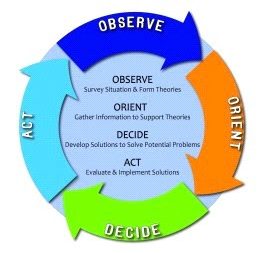OODA LOOP
What is the OODA Loop?
USAF Lt. Col. John Boyd
The concept of the OODA LOOP was developed by USAF Military Strategist Lt. Col. John Boyd and was originally drafted as a tactical fighting concept for air combat between fighter jets during the Vietnam War. Since then, his work has been published and adapted into several domains outside of the military such as law enforcement, self-defense, sports, business, and motivational talks.
OODA stands for Observe, Orient, Decide, Act and it refers to the way our brains handle decision-making processes. It’s called a “Loop” because it’s a continual phenomenon happening inside your brain every second of every day when you are awake and processing information about your surroundings. If one part of the process is interrupted, the loop restarts at Observe. The loop always goes in the order of OODA. Let’s break down each step in the context of boxing. Let’s say somebody is throwing that big classic right haymaker punch at your face.
OBSERVE: You Observe an individual in close proximity to you cocking back their right arm and beginning to turn towards you.
ORIENT: You Orient (perceive) the motion they make to be a right haymaker punch and it’s headed towards your face!
DECIDE: You run through a gamut of options of how to respond to this imminent threat (block the attack, lean back to avoid the attack, etc.).
ACT: You decide to deploy a 360° block with your left hand while simultaneously countering with a right-handed palm strike to the attacker’s face. This knocks them down and you cease any further attacks and choose to run from the location. Mission Accomplished. You went home safe to your family.
That’s OODA in a nutshell. From an attacker’s point of view, OODA goes something like this: OBSERVE the person I want to hurt. ORIENT myself to be in a position to hurt them. DECIDE to punch them in the face with my right fist. ACT, by cocking back my right arm and swinging my fist towards their face.
Now look at the differences in where each person is, in their LOOP. The perpetrator is at ACT, the end of their Loop, when you’re at OBSERVE. It’s important to note that oftentimes in self-defense situations we are behind the 8-ball and forced to fight from a position of disadvantage. Though you are in that disadvantageous position, there’s still hope. Because in their mind, the perpetrator fully expected to make contact with your face and possibly knock you out.
By countering as you did in the above scenario, you forced them to restart their OODA LOOP. Let’s say the initial counter didn’t knock them down so you make a groin kick, causing their Loop to once again reset. You get the idea. When seconds count, disrupting the OODA LOOP can change the dynamic of a situation, give the defendant an advantage unanticipated by the perpetrator and possibly even turn them away.

The OODA LOOP only flows in one direction and always in order, starting and if interrupted re-starting with OBSERVE.

